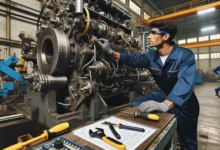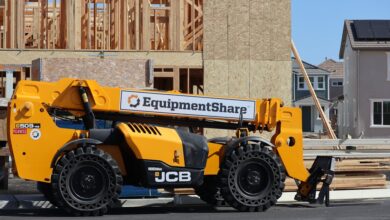Industrial Machinery Diagnostics: Boost Uptime, Cut Costs, and Prevent Unplanned Downtime
Advertisement
When machines keep our factories running smooth every day I know just how crucial it is to spot problems before they turn into costly breakdowns. Industrial machinery diagnostics has become a game changer for anyone who wants to boost efficiency and keep operations on track. With the right diagnostic tools I can catch warning signs early and avoid unexpected downtime.
I’ve seen how investing in smart diagnostics pays off in both time and money. It’s not just about fixing what’s broken—it’s about understanding my equipment inside and out so I can make better decisions. Let’s explore how industrial machinery diagnostics is transforming maintenance strategies and keeping production lines moving.
Understanding Industrial Machinery Diagnostics
- Identifying Common Faults
I usually start by pinpointing typical failure modes in industrial equipment, like overheating, vibration anomalies, or leaks in hydraulic lines. Sensors and historical data help reveal issues in motors, pumps, gearboxes, and conveyors.
- Collecting Diagnostic Data
I collect machine condition data through sensors that measure temperature, pressure, vibration, and noise levels. Modern systems often send this data in real time to a central dashboard for rapid assessment.
- Applying Diagnostic Techniques
I use advanced diagnostics such as vibration analysis, thermal imaging, and oil analysis. For example, I run vibration trend reports to detect bearing wear or shaft imbalances before they escalate.
- Leveraging Predictive Analytics
I apply predictive maintenance algorithms to the data. These tools flag abnormal patterns and forecast potential breakdowns, letting me schedule repairs before failure occurs. Machine learning models improve these predictions by learning from past faults.
- Interpreting Results and Initiating Action
I interpret diagnostic reports to determine if immediate action is needed or if monitoring can continue safely. Decision trees and expert systems help prioritize which assets need the most urgent attention for optimized uptime.
- Documenting and Improving Processes
I document findings and update maintenance logs to ensure traceability. I also refine diagnostic protocols regularly to boost future reliability and minimize recurring faults in industrial machinery.
Exploring Key Diagnostic Tools and Technologies

I rely on a range of industrial machinery diagnostics tools to catch faults early and boost equipment reliability. Here’s how each technology supports my daily diagnostics and predictive maintenance.
Vibration Analysis Systems
I use vibration analysis systems to track changes in machine vibration patterns. These systems identify faults such as misalignment, imbalance, or bearing wear by comparing real-time data to baseline signatures. When I see deviations, I know to schedule checks before minor issues become failures.
Infrared Thermography Equipment
I operate infrared thermography equipment to spot overheating in electrical panels, motors, and bearings. This gear translates invisible heat into visual thermal images, letting me find abnormal hotspots and fix them fast. Catching these thermal anomalies can reduce fire risks and prevent catastrophic equipment damage.
Ultrasonic Testing Devices
I depend on ultrasonic testing devices for pinpointing leaks, electrical discharge, and lubrication issues. These devices detect high-frequency sounds produced by forming cracks, gas leaks, or mechanical wear. Monitoring these sounds helps me act before a small leak leads to unsafe conditions or production stops.
Oil Analysis Kits
I use oil analysis kits to evaluate lubricant condition and contamination. These kits reveal the level of metal particles, moisture, and chemical degradation in the oil. If my testing shows elevated levels, I know there’s likely internal wear or an external contaminant problem that needs immediate attention.
Motor Circuit Analysis Tools
I trust motor circuit analysis tools to diagnose faults in electric motors, including insulation failures, winding imbalances, and resistance issues. These tools give me immediate feedback on motor health, so I can intervene before breakdowns interrupt workflow or damage connected systems.
Implementing Predictive Maintenance Strategies
Implementing predictive maintenance has drastically improved my machinery uptime and reduced the stress of unexpected failures. I maximize equipment lifespan by combining real-time diagnostics and data-driven maintenance planning.
Condition Monitoring Best Practices
I always set up continuous monitoring using sensors for critical parameters like temperature, vibration, and oil quality. I schedule regular calibration checks for my diagnostic tools to keep measurement accuracy high. I select monitoring intervals based on equipment risk levels—daily for high-value machines like compressors, weekly for less critical gear like auxiliary pumps. I train my maintenance team to spot anomalies in dashboards and know when to escalate issues, minimizing false alarms and downtime. I ensure all monitoring activities are logged digitally, creating a traceable maintenance history for every machine.
Data Collection and Analysis Techniques
I standardize data collection by integrating outputs from vibration monitors, infrared thermography, ultrasonics, oil analysis, and motor analyzers into a centralized CMMS (Computerized Maintenance Management System). I use automated alerts in my system to flag deviations from baseline conditions, such as increased bearing vibration or unexpected temperature spikes. I run pattern recognition algorithms on historical data, allowing me to identify early fault signatures before they cause failures. I collaborate with data analysts to build trend reports, which I review monthly to plan targeted maintenance. I regularly update failure and repair documentation, using insights from each incident to refine my predictive models and improve reliability across my facility.
Identifying Common Machinery Faults Through Diagnostics
Spotting faults early in industrial machinery saves downtime and maintenance costs. I rely on focused diagnostic checks to uncover critical issues before they become failures.
Bearing Failures
Bearing failures often show up as increased vibration and audible noise. I use vibration analysis tools to spot changes in amplitude or frequency linked to worn balls, raceways, or cages. Thermal imaging helps me detect localized heat from friction. I check lubricant samples for metal particles or discoloration, which signals internal wear. Tracking these signs lets me replace bearings proactively and avoid sudden equipment stoppages.
Imbalance and Misalignment Issues
Imbalance and misalignment present as persistent, irregular vibration patterns. I use vibration data trending to compare baseline readings with new measurements, quickly flagging out-of-spec imbalances. Laser shaft alignment tools help me visualize and correct angular or parallel misalignment. When detected early, I can realign shafts and rebalance components, reducing excessive bearing and seal wear.
Electrical Faults in Industrial Equipment
Electrical faults—such as insulation deterioration, voltage spikes, or phase imbalances—show up as abnormal motor temperatures and erratic performance. I deploy motor circuit analysis tools and thermal cameras to identify hotspots, while power quality analyzers catch current or voltage anomalies. Monitoring these indicators allows me to address wiring faults, loose connections, or deteriorating windings before they trigger equipment shutdowns.
Lubrication and Contamination Problems
Lubrication and contamination problems lead to friction, overheating, and accelerated part wear. I analyze oil samples in the field, measuring viscosity, moisture, and particle counts to detect contamination or breakdown. Ultrasonic sensors let me monitor lubrication intervals and optimize grease replenishment. By resolving these problems quickly, I extend component life and keep critical machinery running smoothly.
Enhancing Efficiency with Real-Time Diagnostic Solutions
Real-time diagnostic solutions transform how I manage industrial machinery by enabling instant issue detection and response. Using connected technologies, I streamline maintenance decisions and boost overall operational efficiency.
Remote Monitoring Systems
Remote monitoring systems let me track machine performance from anywhere. I use sensors and wireless networks to receive live data on temperature, vibration and power usage. These systems alert me immediately when critical parameters exceed safe thresholds, preventing minor issues from escalating. Real-time dashboards display the status of each asset, so I can prioritize maintenance without physically inspecting every piece of equipment. By integrating remote monitoring, I reduce manual checks and shorten response times during unexpected events.
IoT-Enabled Diagnostic Platforms
IoT-enabled diagnostic platforms connect all my machinery data into a unified digital environment. I leverage cloud-based analytics to identify developing faults across multiple locations with predictive insights. These platforms seamlessly pull data from vibration sensors, energy meters and control systems, showing me trends and anomalies with visual reports. Automated workflows trigger maintenance orders in my CMMS when certain conditions are met. Because everything updates automatically, I focus less on data entry and more on optimizing performance. IoT connectivity ensures my diagnostics are always up to date, increasing uptime and lowering unplanned repair costs.
Overcoming Challenges in Industrial Machinery Diagnostics
I’ve dealt with several hurdles while improving diagnostics workflows, especially when merging new tech with old systems and managing mountains of generated data.
Integrating Diagnostics with Legacy Systems
I often face resistance when adding diagnostic technologies to legacy equipment. Many older machines lack digital interfaces, so I use sensor retrofits and external data loggers for real-time input. I prioritize non-invasive installation, such as wireless vibration sensors or clamp-on temperature probes, to avoid altering critical machine functions. I rely on protocol converters or edge gateways—tools like OPC UA adapters—to translate machine signals for modern platforms, bridging communication gaps. I validate every connection by running pilot projects, confirming compatibility with my existing CMMS and control systems.
Addressing Data Overload
I see massive data streams from sensors, logs, and diagnostic tools, so I need efficient filtering and analysis. I automate initial data sorting with onboard device analytics, flagging only critical anomalies for my attention. I use customizable dashboards in my integrated CMMS to visualize data trends fast. I rely on threshold-based alerting—only receiving notifications for readings outside safe operating limits. I collaborate with IT teams to set up cloud storage, securing data access yet supporting long-term trend analysis. I train my team to interpret analytics outputs rather than raw data, letting them focus on actionable maintenance insights over sifting through noise.
Conclusion
Embracing industrial machinery diagnostics has completely changed how I approach maintenance and reliability. By leveraging advanced tools and data-driven strategies I’ve seen firsthand how much smoother operations can run when issues are caught early and addressed proactively.
Staying current with diagnostic technologies and continuously improving processes ensures I’m always one step ahead of potential failures. This commitment not only protects equipment but also drives productivity and keeps costs in check for the long haul.
Frequently Asked Questions
What is industrial machinery diagnostics?
Industrial machinery diagnostics refers to the process of monitoring and analyzing equipment to detect faults, irregularities, or performance issues early. It uses tools like sensors, vibration analysis, and thermal imaging to identify potential problems before they cause costly breakdowns or downtime.
Why is early fault detection important in factories?
Early fault detection helps prevent unexpected equipment failures, reduces unplanned downtime, and minimizes repair costs. By catching issues early, maintenance teams can address problems proactively, extending machinery lifespan and maintaining efficient production.
What are some common diagnostic tools used in industry?
Common diagnostic tools include vibration analysis systems, infrared thermography cameras, ultrasonic testing devices, oil analysis kits, and motor circuit analyzers. These tools help identify issues like overheating, leaks, mechanical wear, and electrical faults.
How does predictive maintenance benefit factory operations?
Predictive maintenance uses real-time diagnostics and data analytics to predict potential breakdowns, allowing timely interventions. This approach improves machinery uptime, reduces unexpected failures, and helps optimize maintenance resources and planning.
What is vibration analysis and why is it important?
Vibration analysis involves measuring and analyzing machine vibrations to detect abnormalities such as imbalance, misalignment, or bearing wear. It’s important because it reveals problems early, preventing major failures and avoiding costly repairs.
How does real-time diagnostics improve machinery management?
Real-time diagnostics provide instant data on equipment performance, enabling quick detection and response to issues. Connected technologies and IoT platforms increase visibility, automate maintenance alerts, and reduce manual checks, leading to higher machine uptime.
What are some challenges in implementing diagnostic systems?
Common challenges include integrating new diagnostic technologies with older equipment, managing large data volumes, ensuring data security, and training staff to interpret analytics rather than raw data. Overcoming these barriers often requires collaboration between maintenance, IT, and operations teams.
How can data collected from diagnostics be managed effectively?
Data from diagnostics can be managed by integrating it into a centralized Computerized Maintenance Management System (CMMS), using automated alerts, and employing customizable dashboards for visualization. Collaboration with IT and data analysts helps ensure secure storage and actionable trend reporting.
Which machine faults can be detected using diagnostics?
Diagnostics can detect faults such as bearing failures, misalignment, imbalance, electrical problems, and lubrication issues. Techniques like vibration analysis, thermal imaging, and oil analysis help identify these problems early, supporting proactive maintenance.
What best practices should factories follow for condition monitoring?
Best practices include continuous monitoring of critical parameters, regular calibration of diagnostic tools, customized monitoring intervals based on equipment risk, staff training, and maintaining detailed digital records to track machine health and maintenance activities.









